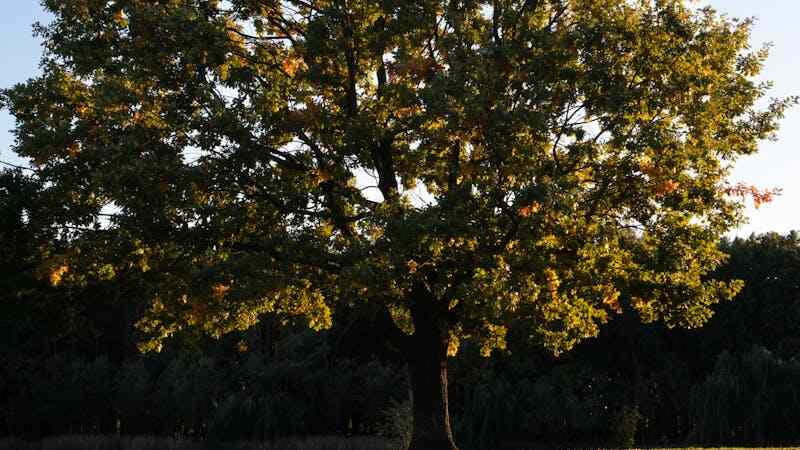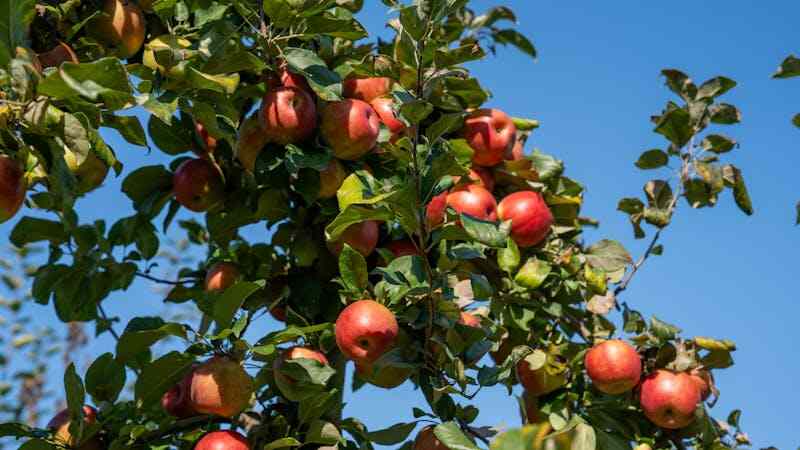Trees, known as nature’s lifeline, are towering pillars of life that shape the very fabric of our environment. They belong to the biological classification of perennial plants with an elongated stem or trunk, supporting branches and leaves. they are more than just a source of shade and beauty; they play an essential role in maintaining the balance of ecosystems.

The vital role they play in spans providing oxygen, supporting wildlife, stabilizing the soil, and contributing to the well-being of humans and nature alike. Trees are undeniably nature’s lifeline, impacting our world in profound ways.
Types of Trees
The diversity of that adds immense value to nature, each type fulfilling a unique ecological role. like oaks and maples, shed their leaves seasonally, whereas coniferous trees, such as pines and spruces, retain their needle-like foliage year-round.
Evergreens stand tall through every season, while fruit-bearing trees provide both nourishment and economic value through their harvest. Each of them type showcases how the vital role they play and deeply intertwined with human life, providing resources and beauty in numerous ways.
- Deciduous Trees:

- Deciduous trees are known for shedding their leaves with seasonal changes, especially in autumn. During cold months or dry seasons, deciduous enter a dormant phase to conserve energy, which allows them to survive in harsh conditions. In the spring, they grow new leaves and continue their growth. Oaks and maples are well-known examples; these trees often provide vibrant fall color before shedding their leaves.
- Coniferous Trees:

- Commonly found in colder regions, conifers are adapted to withstand harsh winters. Their needle-like leaves persist year-round, allowing them to photosynthesize even in colder months. The conical shape of these helps them shed snow, preventing damage. Coniferous trees, such as pine, spruce, and fir, are important for lumber and paper production, as they grow quickly and provide strong wood.
- Evergreen Trees:

- Evergreen trees retain their leaves throughout the year regardless of seasonal changes. This characteristic allows them to remain green and continue photosynthesis throughout the seasons. These are often found in a variety of climates, from tropical to temperate regions. Examples include pine, cypress, and eucalyptus. Evergreens are highly valued for their enduring aesthetic appeal and ability to provide year-round cover and shelter for wildlife.
- Fruit-Bearing Trees: These are cultivated for the production of fruits, which are an important part of human and animal food. such as apple, mango, and orange trees, produce flowers that later become fruit. These trees are integral to agriculture, contributing to the global food supply. Many fruiting species also support ecosystems by providing food for wildlife and pollinators, making them ecologically and economically essential.

Ecological Importance of Trees
Trees are the lungs of the Earth, providing oxygen and sequestering carbon dioxide, contributing to the planet’s health. As nature’s lifeline, they create habitats for countless wildlife species and support entire ecosystems.
They conserve water, reduce the risk of floods, and prevent soil erosion by stabilizing the ground with their roots. Furthermore, they regulate climate, offering shade, reducing urban heat, and absorbing pollutants. Their ecological significance truly underlines the vital role of trees in maintaining life.
- Oxygen Production: Greenery play an important role in maintaining the balance of the atmosphere by converting carbon dioxide into oxygen through the process of photosynthesis. As they absorb sunlight, uses this energy to synthesize food from carbon dioxide and water, releasing oxygen as a byproduct. This process is essential for all oxygen-breathing organisms, ensuring that the air remains clean and breathable. One mature Flora can produce enough oxygen to sustain several humans, making forests the key to life on Earth.
- Habitat for Wildlife: Trees are essential in supporting biodiversity by providing shelter, food, and nesting sites for many wildlife, including birds, insects, mammals, and other creatures. The canopy protects from predators and harsh weather, while bark, leaves, and fruits serve as sources of food. Dead trees or fallen trees also create habitat for fungi and small animals, which contribute to the complex web of life that depends on trees for survival.

- Water Conservation: Tree roots play an important role in water conservation by absorbing rainfall and reducing surface runoff. It helps prevent soil erosion and reduces the risk of flooding. Roots also help water penetrate deeper into the soil, which helps recharge groundwater. In addition, trees release water vapor into the atmosphere through a process called transpiration, which can help regulate local rainfall patterns.
- Climate Regulation: Greenery act as a natural buffer against climate change by absorbing large amounts of carbon dioxide, a major greenhouse gas. Through carbon sequestration, trees sequester carbon, which helps reduce the effects of global warming. Additionally, by providing shade and cooling the air through transpiration,they can reduce urban heat islands and reduce the effects of extreme weather conditions such as heat waves, making them useful for climate regulation efforts and they Can be invaluable.
Trees and the Environment
The vital role of thier extends beyond ecological benefits to improving environmental quality. Through carbon sequestration, they mitigate global warming by acting as carbon sinks, locking away harmful greenhouse gases.
They also purify the air by filtering pollutants, and their organic matter enriches the soil, fostering agricultural productivity. Nature’s lifeline status is evident in their crucial contributions to cleaner air, fertile land, and overall environmental stability.
- Carbon Sequestration: Greenery play an important role in mitigating climate change by absorbing carbon dioxide from the atmosphere during photosynthesis. They store this carbon in their stems, branches, leaves, and roots, reducing the concentration of greenhouse gases. Forests act as long-term carbon sinks, making them essential for combating global warming. By conserving and planting more flora, we increase the planet’s ability to absorb carbon emissions. Deforestation, however, accelerates climate change by releasing stored carbon back into the atmosphere.
- Air Purification: Trees improve air quality by acting as natural filters. Through their leaves and bark, they capture dust, toxins, and pollutants such as sulfur dioxide, ammonia, and nitrogen oxides. Urban greenery, in particular, are effective in reducing smog and particulate matter, making for a healthier environment for people living in cities. Additionally, greenery release oxygen during photosynthesis, which further contributes to clean and fresh air. This cleaning process is especially important in areas where pollution levels are high.
- Soil Fertility: Nature promote soil health by enriching the soil with organic matter through their fallen leaves, twigs, and decaying roots. This organic material improves soil structure, increases its water-holding capacity, and promotes the growth of beneficial microorganisms. Additionally, Nature prevent soil erosion by anchoring the soil with their roots, reducing runoff during heavy rains. This makes trees important allies in sustainable agriculture and land management. Some tree species also fix nitrogen, further increasing soil fertility
Economic Importance of Trees
The economic value of greenery is immense, from the timber industry to medicinal plants. Trees produce wood products like paper and furniture, while countless medicines are extracted from their bark and leaves.
Fruit-bearing trees provide essential crops, sustaining economies around the globe. They also have an invaluable impact on real estate, as urban greening increases property values. This vital role they play in economic stability cements their position as nature’s lifeline not only ecologically but financially.
- Wood Products: Trees provide essential raw materials for a variety of industries, including construction, furniture making, paper production, and fuel. Wood is a renewable resource when harvested sustainably and can be used to build homes, make tools, and generate energy. Products such as paper, cardboard, and packaging materials all come from trees, supporting global trade and everyday human activity. Moreover, wood fuel is the primary source of energy for heating and cooking in many developing regions. Sustainable forestry practices ensure that these resources remain available for future generations.
- Medicinal Uses: Many tree species are valuable sources of medicinal compounds that are used in pharmaceuticals. For example, the bark of the willow tree contains salicin, which makes aspirin. Neem trees are known for their antibacterial and antifungal properties, making them a staple in traditional medicine. Trees provide natural remedies for a variety of ailments, from pain relief to skin care. Continued research into tree-based medicine holds the promise of discovering new treatments and cures for diseases.

- Food Source: Fruit-bearing trees, such as apples, mangoes, and avocados, are important to global agriculture and food security. They provide essential nutrients, vitamins, and fiber that support human health. Apart from direct consumption, the fruits of these trees drive the economy, especially in regions where agriculture is the main source of livelihood. Also, trees like cacao and coffee trees contribute to the production of some of the world’s most beloved beverages. Proper cultivation and management of these trees ensures a stable food supply for the growing population.
Trees and Human Health
Trees don’t just provide material benefits—they positively affect mental and physical health. Walking through a forest or sitting under a tree has been proven to reduce stress and boost mood, showcasing the vital role of trees in psychological well-being. In urban areas, trees reduce pollution, cooling the environment, and creating a healthier living space.
The therapeutic effects of nature, or “forest bathing,” are gaining recognition as a healing practice, further reinforcing the idea that trees are truly nature’s lifeline.
- Mental Health Benefits: Studies show that spending time in nature, from a fast-paced urban environment. Being surrounded by greenery promotes calmness and mindfulness, which boosts emotional well-being. Additionally, walking in wooded areas can improve mood and mental clarity. Overall, they provide a therapeutic preventative that positively affects mental health, especially around trees, and lowers levels of cortisol, a hormone associated with stress. The visual beauty and tranquility of forests or parks offer a natural retreat.
- Urban Greening: Adding trees to cities through urban greening projects improves both the environment and quality of life. Trees help reduce urban temperatures by providing shade and reducing the heat island effect, where cities become significantly warmer than surrounding areas. They also act as natural air filters, removing pollutants from the environment and producing oxygen. Urban trees create aesthetically pleasing spaces, make cities more livable, and promote outdoor activities. By reducing noise pollution and improving air quality, trees contribute to a healthy urban environment. Urban greening efforts are increasingly recognized as a way to increase sustainability and social well-being.

- Therapeutic Effects: Research has shown that spending time in natural environments, especially around trees, has important therapeutic effects. People who spend time outdoors, especially in the woods, often experience better mental clarity and focus. Forest bathing, a practice that originated in Japan, highlights how being exposed to trees and nature can reduce stress, boost the immune system, and increase overall well-being. The presence of trees encourages physical activity like walking or jogging, which further adds to the health benefits. Additionally, natural environments promote better cognitive function and creativity. The combination of fresh air, green spaces, and a peaceful environment creates a restorative effect on the mind and body
Deforestation and Its Consequences
Deforestation is one of the greatest threats to the vital role of trees. As forests are cleared for agriculture, logging, and urban expansion, ecosystems collapse, biodiversity plummets and climate change accelerates.
The destruction of forests undermines nature’s lifeline, leading to soil erosion, habitat loss, and a spike in greenhouse gas emissions. If deforestation continues unchecked, the balance of life that trees support could be lost forever.

- What is Deforestation?: Deforestation is the large-scale cutting of trees, often to make way for agricultural activities, infrastructure development, or urban expansion. This process leads to permanent loss of forests and the ecosystems they support. The main drivers of deforestation include tree planting, cattle ranching, and agriculture, especially in tropical rainforests. Deforestation disrupts the balance of nature, releasing stored carbon into the atmosphere and contributing to climate change. It also has social consequences, affecting local communities that depend on forests for their livelihoods. Stopping deforestation is critical to preserving biodiversity, reducing carbon emissions, and maintaining environmental stability.
- Impact on Biodiversity: Deforestation leads to loss of biodiversity, as forests are home to countless species of plants, animals, and microorganisms. Many species depend on forest habitats for food, shelter, and reproduction and face extinction when forests are destroyed. This damage disrupts the ecosystem, affects the predator-prey relationship, and causes an imbalance in nature. Loss of biodiversity also affects human populations, as forests provide ecosystem services such as pollination, water purification, and climate regulation. In addition, many medicines and foods are derived from wild species, and their loss may limit future discoveries. Conservation of forests is essential to maintain the diversity of life on earth.
- Soil Degradation and Erosion: Trees play an important role in soil stabilization with their root systems, which bind the soil together and prevent erosion. When forests are cleared, the absence of tree roots makes the soil vulnerable to rain or wind washing away, causing erosion. This process degrades land, reducing its fertility and ability to support crops, which can lead to food shortages in affected areas. In landslide-prone areas, deforestation increases the frequency and severity of such events, endangering lives and property. Soil degradation also affects water quality, as eroded soil can pollute nearby streams and rivers. Maintaining tree cover is essential to prevent erosion and maintain agricultural productivity
Conservation of Trees
Global and local initiatives, led by governments and NGOs, focus on tree planting, forest protection, and educating communities on the vital role of trees in sustaining life on Earth.
Conserving the world’s tree cover is critical to maintaining biodiversity, regulating climate and ensuring the continued survival of ecosystems. Tree conservation efforts range from protecting old-growth forests to planting new trees in areas affected by deforestation.
Governments, NGOs, and communities must collaborate to implement sustainable strategies that combat illegal logging, land clearing, and deforestation. Public awareness campaigns and policy changes are also necessary to promote the importance of tree conservation for future generations. Active engagement at local and global levels ensures that tree conservation remains a top priority
- Reforestation and Afforestation: Reforestation refers to the process of planting trees in areas where forests have been lost, restoring ecosystems to their natural state. Afforestation, on the other hand, involves planting trees in areas that were not previously forested, which helps in the expansion of green cover. Both processes are essential for improving biodiversity. increasing soil fertility and stabilizing the local climate. Deforestation helps combat desertification, reduce carbon dioxide levels, and protect wildlife habitats. By replenishing forests, these efforts support ecosystem balance and reduce the impact of deforestation. Together, forests and woodlands play an important role in global climate action.

- Sustainable Forestry: Sustainable forestry involves managing forest resources in a way that maintains forest health while meeting economic needs for timber and other products. This practice ensures that forests are not depleted over time and that logging activities are balanced with tree regeneration. By practicing sustainable practices, forest industries reduce the risk of long-term environmental damage, such as soil erosion and loss of biodiversity. Sustainable forestry also promotes responsible land use, where conservation and resource extraction can coexist. Certification programs, such as the Forest Stewardship Council (FSC), help consumers identify products that come from responsibly managed forests. Ultimately, sustainable forestry practices are key to preserving forest ecosystems for future generations.
- Government and NGO Initiatives: Governments and NGOs around the world play an important role in tree conservation efforts through programs such as reforestation, wildlife conservation and public education campaigns. International organizations such as the United Nations lead global initiatives such as the United Nations Decade on Ecosystem Restoration. which promotes forest restoration and reforestation. National governments formulate policies to prevent illegal logging and promote sustainable forestry. Local NGOs often focus on community-based tree planting, habitat restoration, and educating people about the environmental and economic benefits of forest conservation. These initiatives foster collective action, making tree conservation a shared responsibility. Collaboration with global, national, and local partners ensures that both large-scale and grassroots conservation efforts are successful
How to Contribute
Everyone can make a meaningful impact in protecting trees and the environment by taking small but effective steps. Participating in local conservation efforts, tree planting campaigns, and greening projects are all solid ways to help. Reducing paper waste and supporting companies that use sustainable practices can also promote responsible forestry.
Additionally, spreading awareness about the importance of trees through education and community involvement is key to making a difference on a large scale. By working together, individuals can become champions of environmental protection and ensure that trees continue to thrive
Individuals can play a direct role in protecting nature’s lifeline by participating in local tree-planting campaigns, adopting sustainable practices like reducing paper waste, and getting involved in community greening projects.
- Tree Planting Campaigns: Tree planting campaigns are a direct and effective way of contributing to the environment. These campaigns not only combat reforestation and deforestation but also improve urban areas by creating green spaces. Individuals can volunteer for existing drives or start their projects in their communities. Planting trees increases biodiversity, strengthens ecosystems, and helps sequester carbon emissions, making it one of the most effective ways to mitigate climate change. Through these efforts, every tree planted represents a step toward a healthier, greener future.
- Adopting Sustainable Practices: Adopting eco-friendly habits in daily life is another important way to protect trees and the environment. Reducing paper consumption, recycling, and using digital alternatives can drastically reduce deforestation. Supporting companies that practice sustainable forestry ensures that resources are harvested responsibly. These small lifestyle changes, when widely adopted, can have a significant impact on reducing deforestation and the demand for conservation. By being mindful of the products we use, we can contribute to global efforts to protect nature.
- Community Involvement: Getting involved in local initiatives such as urban greening projects or forest conservation efforts is an effective way to support the environment. Communities can come together to plant trees, restore green spaces, and raise awareness about the importance of forest conservation. Organizing clean-up events, workshops or educational campaigns can inspire others to take action. Additionally, promoting urban greenery helps reduce pollution, improve air quality, and provide shade in cities. Community involvement fosters a sense of shared responsibility and encourages collective action for a healthier planet.
Conclusion
Trees are undoubtedly the lifeblood of our planet, playing a vital role in maintaining ecosystems, human well-being, and environmental stability. Their contribution to oxygen production, wildlife habitat, water conservation, and climate regulation is essential to life on Earth.
As conservationists, it is our collective duty to protect and nurture these magnificent creatures. Whether through conservation, forestry, or valuing the trees around us, we must ensure their survival for future generations. By preserving these green pillars of life, we are not only protecting the environment but also the foundation of human existence.


